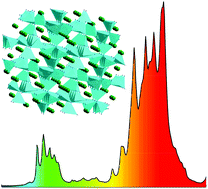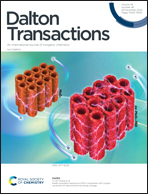Multi-peaked broad-band red phosphor Y3Si6N11:Pr3+ for white LEDs and temperature sensing†
Abstract
The indispensable broad-band red phosphors for LED lighting generally show a long emission tail for wavelengths longer than 650 nm, which consumes excitation energy but contributes little luminance. Here, we report, for the first time, a broad red emission band with a steep falling edge at 652 nm, formed of widely distributed 1D2 → 3H4 emission lines of Pr3+ in Y3Si6N11 due to a large Stark splitting of the 3H4 (930 cm−1) and 1D2 (725 cm−1) levels. The red emission exhibits a 43 nm bandwidth, which is the widest in Pr3+-doped phosphors reported so far. The red Y3Si6N11:Pr3+ phosphor was applied for the fabrication of 310 nm UV chip-based white LEDs, and a high color rendering index of 96 at a low correlated color temperature of 4188 K was achieved. Furthermore, a temperature-sensing scheme was proposed based on the temperature-dependent intensity ratios of the emission lines from the thermally coupled and large Stark splitting levels of the 1D2 state. Relative sensitivities as a function of temperature were studied in the range of 93–473 K. The findings of this study indicate that Y3Si6N11:Pr3+ is an attractive broad-band red phosphor for both high color rendering white LEDs and temperature sensing applications.



 Please wait while we load your content...
Please wait while we load your content...